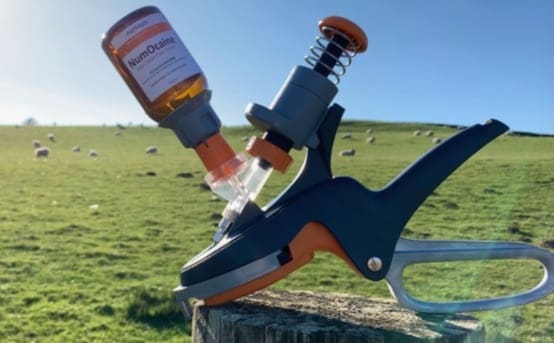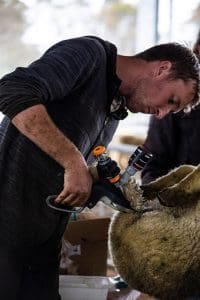
AUSTRALIAN sheep producers are being invited to participate in expanded on-farm commercial trials of the lamb marking pain relief system Numnuts in 2019.
Numnuts involves the injection of the local anaesthetic NumOcaine with a single action, ergonomically designed handheld device that also dispenses a rubber ring for tail-docking and castration.
MLA general manager – producer consultation and adoption, Michael Crowley, said MLA will contribute funding to the next phase of on-farm commercial trials in coming months, including at least partially subsidising the Numnuts applicator cost for producers.
The next research phase will focus on large-scale commercial field trials involving producers, vets and scientists to further assess subjective and objective pain response behaviours.
“Initially, the research will look to include as many of the 500 units of the Numnuts device being made available to Australian sheep producers during this first commercialisation phase.
“The research will look to gather comprehensive on-farm data from producers on the effectiveness of the product and will complement field testing already carried out on 15,000 lambs in 2018 on three properties, including prime lambs and Merinos,” he said.
“Trials of Numnuts in Australia so far have produced positive results for temporarily mitigating pain during lamb marking, and reducing pain-related behaviours such as the ‘tucked up’ posture.
“However, larger numbers of animals need to be treated in order to improve the robustness of the data, and to give producers confidence that Numnuts can provide the animal welfare benefits they seek,” Mr Crowley said.
Numnuts has been developed in a partnership between MLA and Scottish product design and engineering firm 4c Design, and licensed to Senesino for delivery to the Australian sheep industry. Clinical evaluation of Numnuts in Australia has been done by researchers at CSIRO and the University of Melbourne.
Mr Crowley said producers and veterinarians can register their expression of interest on the Numnuts website www.numnuts.co.uk to participate in the commercialisation trials. Participating producers will also need to work with a veterinarians registered to dispense NumOcaine.
There is a limited number of applicators available and sufficient NumOcaine to treat about 450,000 lambs in 2019. A full commercial launch date for the system has not been finalised.
Mr Crowley said the ongoing development of Numnuts provides another tool to mitigate pain for livestock during husbandry procedures, but it also demonstrates that the Australian livestock industry continues to invest in research to ensure we address community concerns about painful husbandry procedures.
“We need to collect more data on-farm to further demonstrate the cost benefits of the product. It is also important to measure other factors that may be influenced through its use such as reducing mismothering and mob droving time.
“Arming producers with the latest on-farm tools and techniques is hugely important, backed up with training to ensure they are capable of accurately assessing pain mitigation procedures.”
Numnuts had a positive impact at Leeming marking

Keith Quail uses Numnuts to put a ring on a Leeming lamb last year.
Victorian prime lamb producers, Tim and Georgie Leeming, Pigeon Ponds, were among the first producers involved in the field testing of Numnuts in 2018.
Mr Leeming said of the more than 10,000 lambs they weaned, Numnuts was used on about 1200 lambs during marking, and had a positive impact.
“Animal welfare is paramount for our operation and using Numnuts in the field trials took away any visual pain – after marking, the lambs were standing up and weren’t displaying signs of pain.
“Another practical benefit was we could bring the mob in, process them and then take them back out to the paddock with their mums without delays, preventing mismothering,” he said.
MLA, Australian Wool Innovation, the Moredun Foundation and CSIRO contributed to the development of Numnuts.

Thank you very much for being looking for solutions and I would like to say that any effort is worthy for pain mitigationa and to improve animal welfare.
Regarding numnuts, this tool or technique helps with the mitigation of the initial “discomfort” after the rubber ring is dispensed (which last no more than 30 minutes).
But are you aware that for both procedures (tail docking and castration) the real pain comes some days after the rubber ring is applied? You should also recommend a deferred analgesia.
Are you considering that? Thanks. Marcia del Campo-INIA Uruguay.
We very pleased with effectiveness of the Numnuts product in its efficiency and efficacy in reducing pain to marked lambs. I am so bemused why producers dock tails with a hot knife. We have not mulesed lambs for 23 years and have always used rings; therefore, a totally blood-free environment. Now that we can take away the acute pain, it means that our whole process is fantastic. It’s easy to the eye of the unaccustomed, with a number of additional production and efficiency benefits. Things are very buoyant in the whole sheep industry and it’s not a time to be complacent. We must embrace proactive measures to improve animal welfare. Tail docking and mulesing should be the first things to go, especially in prime lambs and all their mothers. This should happen right away.
Bruce, as a trial user of the Numnuts products during 2018, I assure you the Numnuts applicator is not clumsy to use. As with adopting most new techniques, in any situation/industry/procedure, within a short adjustment term, say 50 lambs, the use of the new technology becomes efficient and any minimal (nanoseconds) delay is well-compensated by the benefits being achieved in adopting this husbandry/management procedure into the ordinary manner of business of
We used the Numnuts products in 2018 over approximately 5000 lambs.
As Robin has previously confirmed, yes, normal Elastrator rings are utilised to conduct both the tail docking and the castration procedure.
We found it extremely efficient to have the benefit of applying the rings to both testicles and tails in conjunction with quick application of effective pain relief, without having to change tools/implements during the lamb marking process. By using the same tool for castration and tail docking we have the same opportunity to administer effective pain relief at the optimum site, to maximise the pain relief (caused by two procedures for ram lambs) and minimise the “checking” and set backs for all lambs.
I’m sure Bruce, that you’re only too familiar with the need to minimise the product/supplies/tools/equipment that you are required to have sitting on the 44 gallon drum desktop at your side during lamb marking, to minimise the catastrophe when a lamb runs where you thought ‘no lamb would run into that in a million years’.
The use of the Numnuts products is effective and efficient to assist in maintaining our optimum animal welfare practices which support the maintenance of the worldwide accredited standards we hold for the marketing/endorsement of our proudly produced, and suited to, Australian wool and sheep products.
And yes we are currently users of your Leader flock and EID tag products.
Jodie Green
Hi Bruce,
You asked a similar question on a previous article on Sheep Central in Oct 2018, I have copied my answer here in case you missed my response last time round.
Couple of points;
1.Yes the Numnuts tool uses rubber rings, either Elastrator or your Leader rings
2.If producers wish to still remove the tail with a hot knife, the flexibility to do that is in place with the ‘ring and remove’ method. Our position is that we would rather not see blood on farms, hence rings would be our preferred method.
Previous response….
Robin here – I am the creator of the Numnuts device. You ask a good question.
Before developing Numnuts, the first people we spoke to were farmers and vets. Vets told us, based on 30 years of research in Australia, New Zealand and the UK, that their preferred drug for pain relief for castration and tail docking with rings is injectable local anaesthesia. It provides fast-acting pain relief. The vast majority of pain from rings is experienced in the first 45 minutes, when nerves conduct pain sensations to the brain caused by the loss of blood flow to the scrotum and tail. Local anaesthetic blocks this pain conduction.
With this veterinary advice on board, we then looked at the key issues for farmers and contractors around administering localised fast-acting pain relief in a farm environment. The key issues were:
1. Speed: we need to avoid anything that slows down the marking operation, such as the double action of putting one tool down to pick up another, or that requires a second operator. The cost of double operation, multiplied by the thousands of lambs that are going through Australian production systems each year, is greater that the cost of our system.
2. Safety: we need to minimise the risks of needle stick injury and inappropriate use of a vet-supplied S4 drug. The Numnuts system keeps the needle well away from the human operator. Most vaccinators we have seen on farms have been used without needle guards. The ones with guards are bulkier at the tip, can be more fiddly and slower to operate, and make it difficult to access the tight confined spaces we need to get to around the tail and testicles. The design of the Numnuts ‘pain relief cartridge’ helps prevent misuse of the S4 drug.
3. Skill: we need to build into the instrument the skill needed for accurate delivery of local anaesthetic. The key to using small doses of local anaesthetics is the very accurate placement of the drug that is required to block the spermatic and dorsal nerves that transmit pain. The unique aspect of Numnuts is the consistent positioning it enables, without requiring an in-depth knowledge of sheep anatomy. This design feature of Numnuts took a long time to develop and is patented. We use the Elastrator ring as an integral part of the system. The ring bunches the nerves together and holds them firmly in position for accurate, targeted delivery of the local anaesthetic to exactly where it is needed to achieve maximum pain relief benefit, each time, every time. It is the high levels of repeatability and throughput, combined with lower levels of operator skill, that we believe makes this device special and good value. An alternative is for the farmer to employ a vet to perform the procedure with local anaesthetic.
It has taken a great deal of R&D to create Numnuts. I hope what we have built will be of value to the Australian farming community (and their sheep!), and that it will also appeal to domestic and international consumers of Australian sheep products.
I don’t understand why the pain relief could not be given by normal injection, then the ring applied, saving the cost of the applicator and giving time for the pain relief to take effect. The tool looks very clumsy to use. Are normal marking rings used? Most use our lamb docking iron on the tail, rather than rings.
I’m interested in feedback.